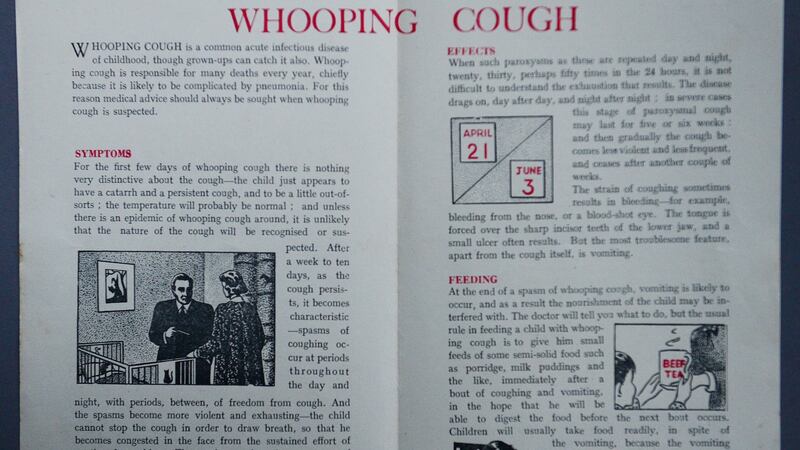In the mid-1950s, the Department of Health circulated an envelope of eight pamphlets to houses nationwide, with an accompanying letter from minister for health James Ryan. These "Health Hints for the Home" offer an insight into the chief public health concerns – and contemporary medical advice – of that decade. Though some of the advice is now obsolete – even dangerous – some remains relevant today.
The sixth of these leaflets concerned itself with whooping cough.
Intro
Whooping cough is a common acute infectious disease of childhood, though grown-ups can catch it also… responsible for many deaths every year, chiefly because it is likely to be complicated by pneumonia.
Symptoms
For the first few days of whooping cough there is nothing very distinctive about the cough… and unless there is an epidemic of whooping cough around, it is unlikely that the nature of the cough will be recognised or suspected. After a week to 10 days, as the cough persists, it becomes characteristic-spasms of coughing occur at periods throughout the day and night, with periods, between, of freedom from cough. And the spasms become more violent and exhausting – the child cannot stop the cough in order to draw breath… Then, when at last the paroxysm of coughing stops, and the child does manage to draw a breath, you will hear the noisy crowing or whooping gasp for air which has given the disease its name.

Effects
When such paroxysms as these are repeated day and night, 20, 30, perhaps 50 times in the 24 hours, it is not difficult to understand the exhaustion that results…in severe cases this stage of paroxysmal coughing may last for five or six weeks: and then gradually the cough becomes less violent and less frequent, and ceases after another couple of weeks.
The strain of coughing sometimes results in bleeding – for example bleeding from the nose, or a blood-shot eye. The tongue is forced over the sharp incisor teeth of the lower jaw, and a small ulcer often results. But the most troublesome feature, apart from the cough itself, is vomiting.
Feeding
At the end of a spasm of whopping cough, vomiting is likely to occur, and as a result the nourishment of the child may be interfered with. The doctor will tell you what to do, but the usual rule in feeding a child with whooping cough is to give him small feeds of some semi-solid food such as porridge, milk puddings and the like, immediately after a bout of coughing and vomiting. Children will usually take food readily…because the vomiting is not accompanied by nausea.
Treatment
By the use of sedatives, quiet surroundings, and careful attention to the supply of fluids and food in small frequent portions, the average child can be nursed through an attack without much loss of flesh, and as soon as the disease starts to decline convalescence should be rapid, provided a change of scene in warm sunny weather can be obtained… The most serious complications are pneumonia, convulsions, and infection of the ear, but with modern methods of treatment there are not as dangerous as formerly, provided they are recognised early and to ensure this you should send for the doctor as soon as you can.
Health Hints for the home
Part 1: The menace of diphtheria
Part 2: If your child has mumps
Part 3: Flies on food
Part 4: Pain in the throat
Part 5: Coughs in Children
Part 6: Whooping gasp for air
Part 7: Dental health
Part 8: Worms in children







